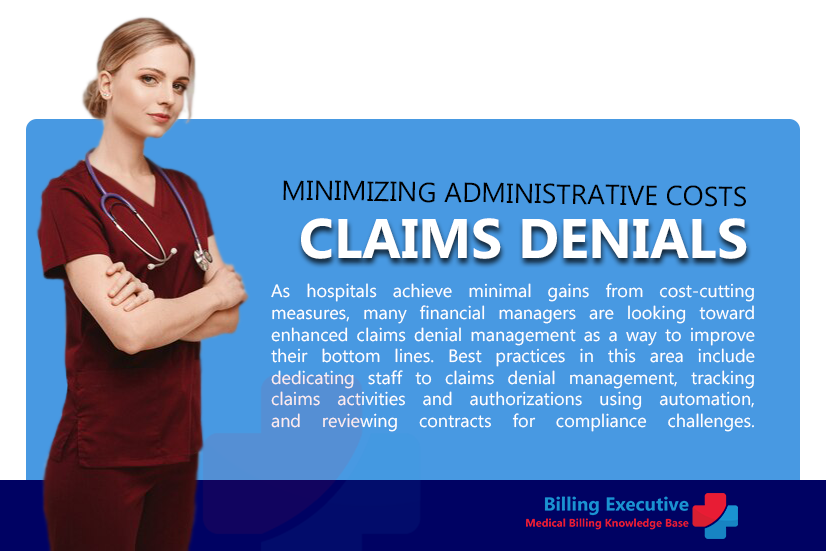The COVID-19 pandemic has placed an unparalleled strain on global healthcare systems. On the other hand, the pandemic has speeded up the digitization of healthcare operations. That is particularly true for health facilities and other primary care providers’ billing and coding functions, with error-free, coherent documentation and claims processing becoming the main factors for a consistent revenue cycle for healthcare organizations.

One goal of medical coding is to accurately capture the services provided to patients and submit reimbursement claims to payers. Mistakes in the coding and documentary evidence process, on the other hand, frequently result in claim denial.
Understanding the Most Common Reasons for Denials
Claims are rejected for various reasons, including incorrect or incomplete paperwork, faulty diagnosis, and failure to meet filing deadlines. The following are the different types of claim denials:
Soft Denial: This temporary denial can be settled by providers taking follow-up actions and does not necessitate an appeal. Inaccurate or incomplete data, billing or coding concerns, and pending invoices and itemized bills are common causes of soft denials.
Hard Denial: This type of rejection results in revenue write-offs and necessitates the submission of an appeal to restore the reimbursement. Some of the causes for this type of denial include a lack of pre-authorization, late filings, non-covered services, and service wrapping.
Preventable or Avoidable Denial: Preventable denials are complex denials that occur due to insufficient action on the part of service providers. They usually involve optional services that could have been postponed or delayed, and they account for nearly 90% of all refusals. Preventable denials are caused by errors in enrollment and other documentation, ineligibility for insurance coverage, medical needs, and incorrect coding and credentialing.
Clinical denial: This denial can take place due to factors such as medical reasons, quality of care, and length of patient stay. A clinical rejection can occur while a patient is still obtaining care in a hospital or after they have been discharged. This payment delay is generally caused by the need for additional medical and clinical explanations.
Technical or Administrative Denial: The payer notifies the supplier on the occasion of a technical or administrative denial. In most cases, it is done in the form of a request form, which clarifies the purpose of the disclaimer. These claims can be recovered by submitting required additional documents on time, including health records, coding clarity, and detailed bills.
Medical Coding Errors and Best Practices
Unbundling, use of numerous CPT codes, upcoding, attaching inaccurate modifiers, excessive modifiers, inappropriate reporting of infusion, hydration, and infusion codes, unregistered reporting of unregistered regulations, and neglecting to stay current with the latest coding measures and guidelines are some of the most common coding errors.
Medical coding adds significant value to healthcare organizations and assists them in reducing claim denials. However, to achieve the best results, businesses must adhere to the following best practices:
Keeping up with coding rules: Medical coding is known for having frequent recommendation and mandate adjustments. In such a case, coders must be well-versed in traditional coding rules while keeping up to date with new regulations and ensuring that their codes adhere to all recommended standards.
Guaranteeing patient information: Healthcare organizations must process claims based on complete data. As a result, it is essential to double-check all patient data and the insurance coverage for which they are qualified. Incorrect information and a lack of verification frequently result in high claim denial rates.
Achieve precise medical billing: To avoid errors that result in claim denials, healthcare professionals must invest adequately in medical billing resources. Adequate emphasis must be placed on the most comprehensive and well-rounded medical billing software and the most specialized and skilled medical billers.
Developing a full proof submission process: The final stage must always be a thorough review of all records before submitting a claim. It has been observed that failing to diligently check files before submission results in denied claims, necessitating the time-consuming and expensive process of submitting and appealing.
To stay ahead of the competition, healthcare organizations are moving steadily toward advancing and implementing it on time. That is where computer-assisted coding (CAC) software can help to improve coding productivity and healthcare outcomes. As a result, selecting the right technology solutions provider is critical. Organizations must collaborate with a multifaceted and forward-thinking technology provider to achieve medical coding excellence and significantly reduce claims denials.
We are the only fully integrated service provider who can help healthcare institutions enhance their coding and documentary evidence processes while ensuring negligible lost revenues from denied claims.
About us
Billing Executive – a Medical Billing and Coding Knowledge Base for Physicians, Office staff, Medical Billers and Coders, including resources pertaining to HCPCS Codes, CPT Codes, ICD-10 billing codes, Modifiers, POS Codes, Revenue Codes, Billing Errors, Denials and Rejections.
We have more than 10 years experience in US Medical Billing and hand-on experience in Web Management, SEO, Content Marketing & Business Development with Research as a special forte.
Learn More
How to decode common Denial Codes in a Medical Practice
Overview of Denial code CO18 Management
Complete Medicare Denial Codes List – Updated
CO 40 Denial Code: Why Insurance deny Emergency Room claims?
